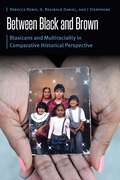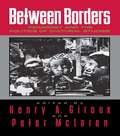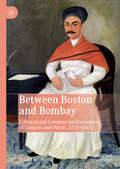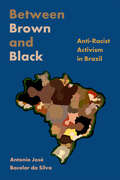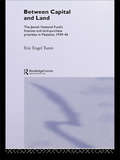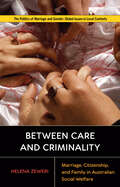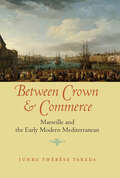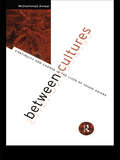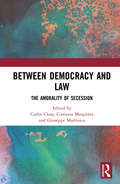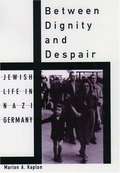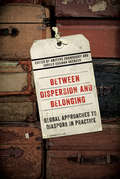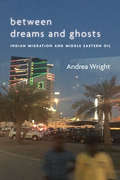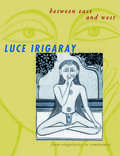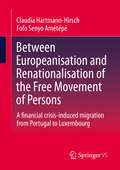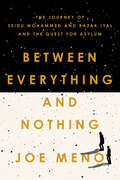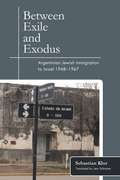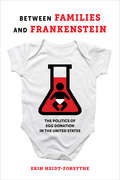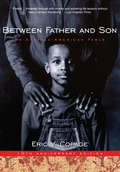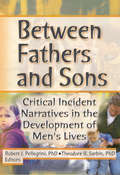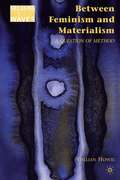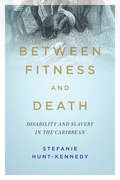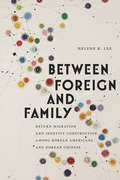- Table View
- List View
Between Black and Brown: Blaxicans and Multiraciality in Comparative Historical Perspective (Borderlands and Transcultural Studies)
by Rebecca Romo G. Reginald Daniel J SterphoneBetween Black and Brown begins with a question: How do individuals with one African American parent and one Mexican American parent identify racially and ethnically? In answer, the authors explore the experiences of Blaxicans, individuals with African American and Mexican American heritage, as they navigate American culture, which often clings to monoracial categorizations. Part 1 analyzes racial formation and the Blaxican borderlands, comparing racial orders in Anglo-America and Latin America. The Anglo-Americanization of &“Latin&” North America, particularly in the Gulf Coast and Southwest regions, shapes Black and Mexican American identities. Part 2 delves into Blaxicans&’ lived experiences, examining their self-identification with pride and resilience. The book explores challenges and agency in navigating family, school, and community dynamics and discusses expectations regarding cultural authenticity. It also delves into Black and Brown relations and how situational contexts influence interactions. This work contributes to the discourse on multiracial identities and challenges prevailing monoracial norms in academia and society. Ultimately Between Black and Brown advocates for a more inclusive and nuanced understanding of identity, race, and culture.
Between Borders: Pedagogy and the Politics of Cultural Studies
by Henry A. Giroux Peter McLarenInformed by the belief that critical pedagogy must move beyond the classroom if it is to be truly effective, this essay collection makes clear how cultural practices--as portrayed in film, sports, and in the classroom itself--enable cultural studies to deepen its own political possibilities and to construct diverse geographies of identity, representation and place. Contributors: Henry A. Giroux, Ava Collins, Nancy Fraser, Carol Becker, bell hooks, Michael Eric Dyson, Roger I. Simon, Chandra Talpede Mohanty, Simon Watney, Michele Wallace, Peter McLaren, David Trend, Abdul R. JanMohamed and Kenneth Mostern.
Between Boston and Bombay: Cultural and Commercial Encounters of Yankees and Parsis, 1771–1865
by Jenny RoseA few years after the American declaration of independence, the first American ships set sail to India. The commercial links that American merchant mariners established with the Parsis of Bombay contributed significantly to the material and intellectual culture of the early Republic in ways that have not been explored until now. This book maps the circulation of goods, capital and ideas between Bombay Parsis and their contemporaries in the northeastern United States, uncovering a surprising range of cultural interaction. Just as goods and gifts from the Zoroastrians of India quickly became an integral part of popular culture along the eastern seaboard of the U.S., so their newly translated religious texts had a considerable impact on American thought. Using a wealth of previously unpublished primary sources, this work presents the narrative of American-Parsi encounters within the broader context of developing global trade and knowledge.
Between Brown and Black: Anti-Racist Activism in Brazil
by Antonio José SilvaWith new momentum, the Brazilian black movement is working to bring attention to and change the situation of structural racism in Brazil. Black consciousness advocates are challenging Afro-Brazilians to define themselves and politically organize around being black, and more Afro-Brazilians are increasingly doing so. Other segments of the Brazilian black movement are working to influence legislation and implement formal mechanisms that aim to promote racial equality, including Affirmative Action Racial Verification Committees. For advocates of these committees, one needs to be phenotypically black enough to be a more likely target of racism to qualify for Affirmative Action programs. Paradoxically, individuals are told to identify as black but only some people are considered black enough to benefit from these policies. Afro-Brazilians are presented with a whole range of identity choices, from how to classify oneself, to whether one votes for political candidates based on shared racial experiences. Between Brown and Black argues that Afro-Brazilian activists’ continued exploration of blackness confronts anti-blackness while complicating understandings of what it means to be black. Blending linguistic and ethnographic accounts, this book raises complex questions about current black struggles in Brazil and beyond, including the black movements’ political initiatives and antiracist agenda.
Between Capital and Land: The Jewish National Fund's Finances and Land-Purchase Priorities in Palestine, 1939-1945 (Israeli History, Politics and Society)
by Eric Engel TutenTuten shows how the Jewish National Fund (JNF) proved to be flexible in its fundraising to obtain its land-purchase objectives during the Second World War. He provides a detailed examination of the Jewish National Fund's internal development and analyses the relationship between JNF's finances and land purchase priorities. A valuable addition to recent re-evaluations of Israeli history and institutions, this book will be of interest to those researching Palestinian history, Jewish and Israeli history and the history of the modern Middle East.
Between Care and Criminality: Marriage, Citizenship, and Family in Australian Social Welfare (Politics of Marriage and Gender: Global Issues in Local Contexts)
by Helena ZeweriBetween Care and Criminality examines social welfare’s encounter with migration and marriage in a period of intensified border control in Melbourne, Australia. It offers an in-depth ethnographic account of the effort to prevent forced marriage in the aftermath of a 2013 law that criminalized the practice. Disproportionately targeted toward Muslim migrant communities, prevention efforts were tasked with making the family relations and marital practices of migrants objects of policy knowledge in the name of care and community empowerment. Through tracing the everyday ways that direct service providers, police, and advocates learned to identify imminent marriages and at-risk individuals, this book reveals how the domain of social welfare becomes the new frontier where the settler colonial state judges good citizenship. In doing so, it invites social welfare to reflect on how migrant conceptions of familial care, personhood, and mutual obligation become structured by the violence of displacement, borders, and conditional citizenship.
Between Crown & Commerce: Marseille and the Early Modern Mediterranean (The Johns Hopkins University Studies in Historical and Political Science #129)
by Junko TakedaThis “carefully argued and well-written study” examines French royal statecraft in the globalizing economy of the early modern Mediterranean (Choice).This is the story of how the French Crown and local institutions accommodated one another as they sought to forge acceptable political and commercial relationships. Junko Thérèse Takeda tells this tale through the particular experience of Marseille, a port the monarchy saw as key to commercial expansion in the Mediterranean.At first, Marseille’s commercial and political elites were strongly opposed to the Crown’s encroaching influence. Rather than dismiss their concerns, the monarchy cleverly co-opted their civic traditions, practices, and institutions to convince the city’s elite of their important role in Levantine commerce. Chief among such traditions were local ideas of citizenship and civic virtue. As the city’s stature throughout the Mediterranean grew, however, so too did the dangers of commercial expansion as exemplified by the arrival of the bubonic plague. During the crisis, Marseille’s citizens reevaluated merchant virtue, while the French monarchy found opportunities to extend its power.Between Crown and Commerce deftly combines a political and intellectual history of state-building, mercantilism, and republicanism with a cultural history of medical crisis. In doing so, the book highlights the conjoined history of broad transnational processes and local political change.
Between Cultures: Continuity and Change in the Lives of Young Asians
by Muhammad AnwarBetween Cultures considers the position of young Asians in Britain in relation to education, employment, housing, the police and the responses they encounter from these institutions. It explores the cultural issues of family, marriage, religion and mother tongue, and the roles of Asian parents and the Asian community are analysed. Muhammad Anwar goes on to compare the situation of young Asians with that of young people generally, and to those in similar circumstances but with different backgrounds and religions.
Between Democracy and Law: The Amorality of Secession
by Carlos Closa Costanza Margiotta Giuseppe MartinicoThis volume purports to explore the legal and political issues triggered by the new wave of secessionism. More specifically, those issues concern the interplay between notions of democracy (and democratic ends and means) and law (and the rule of law and constitutionalism). Against this background, the editors use amorality in order to escape the terrain of the justification of secession by making a distinction between the democratic theory of secession and the theory of democratic secession. In the first section, the theoretical nexus democracy-secession has been approached both from a legal and political theory perspective. The second section of the book examines the instruments that the theory of democratic secession invokes in order to justify secession and presents both legal and political science contributions. The third section focuses on social movements and political actors. The fourth section focuses on two case studies due to the awareness of the importance of the difference between secession in a democratic occidental context (which call into play the discussion of the democratic theories) and separations in a non-democratic context (where the nexus between secession and democracy is not really central).
Between Dignity and Despair: Jewish Life in Nazi Germany
by Marion A. KaplanBetween Dignity and Despair draws on the extraordinary memoirs, diaries, interviews, and letters of Jewish women and men to give us the first intimate portrait of Jewish life in Nazi Germany. Kaplan tells the story of Jews in Germany not from the hindsight of the Holocaust, nor by focusing on the persecutors, but from the bewildered and ambiguous perspective of Jews trying to navigate their daily lives in a world that was becoming more and more insane. Answering the charge that Jews should have left earlier, Kaplan shows that far from seeming inevitable, the Holocaust was impossible to foresee precisely because Nazi repression occurred in irregular and unpredictable steps until the massive violence of November 1938. Then the flow of emigration turned into a torrent, only to be stopped by the war. By that time Jews had been evicted from their homes, robbed of their possessions and their livelihoods, shunned by their former friends, persecuted by their neighbors, and driven into forced labor. For those trapped in Germany, mere survival became a nightmare of increasingly desperate options. Many took their own lives to retain at least some dignity in death; others went underground and endured the fears of nightly bombings and the even greater terror of being discovered by the Nazis. Most were murdered. All were pressed to the limit of human endurance and human loneliness. Focusing on the fate of families and particularly women's experience, Between Dignity and Despair takes us into the neighborhoods, into the kitchens, shops, and schools, to give us the shape and texture, the very feel of what it was like to be a Jew in Nazi Germany.
Between Dispersion and Belonging: Global Approaches to Diaspora in Practice (McGill-Queen's Studies in Ethnic History #110)
by Amitava Chowdhury Donald Harman AkensonAs a historical and religious term "diaspora" has existed for many years, but it only became an academic and analytical concept in the 1980s and ’90s. Within its various usages, two broad directions stand out: diaspora as a dispersion of people from an original homeland, and diaspora as a claim of identity that expresses a form of belonging and also keeps alive a sense of difference. Between Dispersion and Belonging critically assesses the meaning and practice of diaspora first by engaging with the theoretical life histories of the concept, and then by examining a range of historical case studies. Essays in this volume draw from diaspora formations in the pre-modern Indian Ocean region, read diaspora against the concept of indigeneity in the Americas, reassess the claim for a Swedish diaspora, interrogate the notion of an "invisible" English diaspora in the Atlantic world, calibrate the meaning of the Irish diaspora in North America, and consider the case for a global Indian indentured-labour diaspora. Through these studies the contributors demonstrate that an inherent appeal to globality is central to modern formulations of diaspora. They are not global in the sense that diasporas span the entire globe, rather they are global precisely because they are not bound by arbitrary geopolitical units. In examining the ways in which academic and larger society discuss diaspora, Between Dispersion and Belonging presents a critique of modern historiography and positions that critique in the shape of global history. Contributors include William Safran (University of Colorado Boulder), James T. Carson (Queen's University), Eivind H. Seland (University of Bergen), Don MacRaild (University of Ulster), and Rankin Sherling (Marion Military Institute: the Military College of Alabama).
Between Dreams and Ghosts: Indian Migration and Middle Eastern Oil (Stanford Studies in Middle Eastern and Islamic Societies and Cultures)
by Andrea WrightMore than one million Indians travel annually to work in oil projects in the Gulf, one of the few international destinations where men without formal education can find lucrative employment. Between Dreams and Ghosts follows their migration, taking readers to sites in India, the United Arab Emirates, and Kuwait, from villages to oilfields and back again. Engaging all parties involved—the migrants themselves, the recruiting agencies that place them, the government bureaucrats that regulate their emigration, and the corporations that hire them—Andrea Wright examines labor migration as a social process as it reshapes global capitalism. With this book, Wright demonstrates how migration is deeply informed both by workers' dreams for the future and the ghosts of history, including the enduring legacies of colonial capitalism. As workers navigate bureaucratic hurdles to migration and working conditions in the Gulf, they in turn influence and inform state policies and corporate practices. Placing migrants at the center of global capital rather than its periphery, Wright shows how migrants are not passive bodies at the mercy of abstract forces—and reveals through their experiences a new understanding of contemporary resource extraction, governance, and global labor.
Between East and West: From Singularity to Community (European Perspectives: A Series in Social Thought and Cultural Criticism)
by Luce IrigarayWith this book we see a philosopher well steeped in the Western tradition thinking through ancient Eastern disciplines, meditating on what it means to learn to breathe, and urging us all at the dawn of a new century to rediscover indigenous Asian cultures. Yogic tradition, according to Irigaray, can provide an invaluable means for restoring the vital link between the present and eternity—and for re-envisioning the patriarchal traditions of the West. Western, logocentric rationality tends to abstract the teachings of yoga from its everyday practice—most importantly, from the cultivation of breath. Lacking actual, personal experience with yoga or other Eastern spiritual practices, the Western philosophers who have tried to address Hindu and Buddhist teachings—particularly Schopenhauer—have frequently gone astray. Not so, Luce Irigaray. Incorporating her personal experience with yoga into her provocative philosophical thinking on sexual difference, Irigaray proposes a new way of understanding individuation and community in the contemporary world. She looks toward the indigenous, pre-Aryan cultures of India—which, she argues, have maintained an essentially creative ethic of sexual difference predicated on a respect for life, nature, and the feminine. Irigaray's focus on breath in this book is a natural outgrowth of the attention that she has given in previous books to the elements—air, water, and fire. By returning to fundamental human experiences—breathing and the fact of sexual difference—she finds a way out of the endless sociologizing abstractions of much contemporary thought to rethink questions of race, ethnicity, and globalization.
Between East and West: From Singularity to Community
by Stephen Pluhácek Luce IrigarayWith this book we see a philosopher well steeped in the Western tradition thinking through ancient Eastern disciplines, meditating on what it means to learn to breathe, and urging us all at the dawn of a new century to rediscover indigenous Asian cultures. Yogic tradition, according to Irigaray, can provide an invaluable means for restoring the vital link between the present and eternity -- and for re-envisioning the patriarchal traditions of the West. Western, logocentric rationality tends to abstract the teachings of yoga from its everyday practice -- most importantly, from the cultivation of breath. Lacking actual, personal experience with yoga or other Eastern spiritual practices, the Western philosophers who have tried to address Hindu and Buddhist teachings -- particularly Schopenhauer -- have frequently gone astray. Not so, Luce Irigaray. Incorporating her personal experience with yoga into her provocative philosophical thinking on sexual difference, Irigaray proposes a new way of understanding individuation and community in the contemporary world. She looks toward the indigenous, pre-Aryan cultures of India -- which, she argues, have maintained an essentially creative ethic of sexual difference predicated on a respect for life, nature, and the feminine. Irigaray's focus on breath in this book is a natural outgrowth of the attention that she has given in previous books to the elements -- air, water, and fire. By returning to fundamental human experiences -- breathing and the fact of sexual difference -- she finds a way out of the endless sociologizing abstractions of much contemporary thought to rethink questions of race, ethnicity, and globalization.
Between Europeanisation and Renationalisation of the Free Movement of Persons: A financial crisis-induced migration from Portugal to Luxembourg
by Claudia Hartmann-Hirsch Fofo Senyo AmétépéLuxembourg has an atypical, efficient migration. The recent Portuguese underclass themselves in the same way as their predecessors of the Salazar regime, despite higher educational attainment, while the citizens of the new member states move to the top of the pyramid. The strong north-south divide between Luxembourg and Portugal is illustrated by a number of indicators. Freedom of movement is reduced and renationalised by ECJ rulings on the initiative of northern member states against southern European crisis 'refugees'. The categories of EU citizens versus third-country nationals develop into economically strong EU and non-EU migrants versus weak EU and non-EU migrants.
Between Everything and Nothing: The Journey of Seidu Mohammed and Razak Iyal and the Quest for Asylum
by Joe MenoA New York Times Book Review Editor's Choice, this harrowing true story of two young men from Ghana and their quest for asylum highlights not only the unjust political system of their homeland, but the chaos of the United States’ failing immigration system.Long before their chance meeting at a Minneapolis bus station, Ghanaian asylum seekers Seidu Mohammed and Razak Iyal had already crossed half the world in search of a new home. Seidu, who identifies as bisexual, lived under constant threat of exposure and violence in a country where same–sex acts are illegal. Razak’s life was also threatened after corrupt officials contrived to steal his rightful inheritance.Forced to flee their homeland, both men embarked on separate odysseys through the dangerous jungles and bureaucracies of South, Central, and North America. Like generations of asylum seekers before, they presented themselves legally at the U.S. border, hoping for sanctuary. Instead they were imprisoned in private detention facilities, released only after their asylum pleas were denied. Fearful of returning to Ghana, Seidu and Razak saw no choice but to attempt one final border crossing. Their journey north to Canada in the harsh, unforgiving winter proved more tragic than anything they had experienced before.Based on extensive interviews, Joe Meno’s intimate, novelistic account builds upon the international media attention Seidu and Razak’s story has already received, highlighting the harrowing journey of asylum seekers everywhere while adding dimension to one of the greatest humanitarian concerns facing the world.
Between Exile and Exodus: Argentinian Jewish Immigration to Israel, 1948–1967
by Sebastian Klor Lenn SchrammBetween Exile and Exodus: Argentinian Jewish Immigration to Israel, 1948–1967 examines the case of the 16,500 Argentine Jewish immigrants who arrived in Israel during the first two decades of its existence (1948–1967). Based on a thorough investigation of various archives in Argentina and Israel, author Sebastian Klor presents a sociohistoric analysis of that immigration with a comparative perspective. Although many studies have explored Jewish immigration to the State of Israel, few have dealt with the immigrants themselves. Between Exile and Exodus offers fascinating insights into this migration, its social and economic profiles, and the motivation for the relocation of many of these people. It contributes to different areas of study— Argentina and its Jews, Jewish immigration to Israel, and immigration in general. This book’s integration of a computerized database comprising the personal data of more than 10,000 Argentinian Jewish immigrants has allowed the author to uncover their stories in a direct, intimate manner. Because immigration is an individual experience, rather than a collective one, the author aims to address the individual’s perspective in order to fully comprehend the process. In the area of Argentinian Jewry it brings a new approach to the study of Zionism and the relations of the community with Israel, pointing out the importance of family as a basis for mutual interactions. Klor’s work clarifies the centrality of marginal groups in the case of Jewish immigration to Israel, and demystifies the idea that Aliya from Argentina was solely ideological. In the area of Israeli studies the book takes a critical view of the “catastrophic” concept as a cause for Jewish immigration to Israel, analyzing the gap between the decision-makers in Israel and in Argentina and the real circumstances of the individual immigrants. It also contributes to migration studies, showing how an atypical case, such as the Argentine Jewish immigrants to Israel, is shaped by similar patterns that characterize “classical” mass migrations, such as the impact of chain migrations and the immigration of marginal groups. This book’s importance—its contribution to the historical investigation of the immigration phenomenon in general, and specifically immigration to the State of Israel—lies in uncovering and examining individual viewpoints alongside the official, bureaucratic immigration narrative.Scholars in various fields and disciplines, including history, Latin American studies, and migration studies, will find the methodology utilized in this monograph original and illuminating.
Between Families and Frankenstein: The Politics of Egg Donation in the United States
by Erin Heidt-ForsytheIn the United States, egg donation for reproduction and egg donation for research involve the same procedures, the same risks, and the same population of donors—disadvantaged women at the intersections of race and class. Yet cultural attitudes and state-level policies regarding egg donation are dramatically different depending on whether the donation is for reproduction or for research. Erin Heidt-Forsythe explores the ways that framing egg donation itself creates diverse politics in the United States, which, unlike other Western democracies, has no centralized method of regulating donations, relying instead on market forces and state legislatures to regulate egg donation and reproductive technologies. Beginning with a history of scientific research around the human egg, the book connects historical debates about the “natural” (reproduction) and “unnatural” (research) uses of women’s eggs to contemporary political regulation of egg donation. Examining egg donation in California, New York, Arizona, and Louisiana and coupled with original data on how egg donation has been regulated over the last twenty years, this book is the first comprehensive overview and analysis of the politics of egg donation across the United States.
Between Father and Son
by Eric V. CopageThirteen-year-old Jordan Garrison is at a crossroads. He's just about to enter high school, and his biggest worries are his new bottom-of-the-totem-pole status as an incoming freshman and his father's constant lectures about becoming a man. Growing further apart from his younger siblings-precocious eight-year-old twins-Jordan thinks his only ally is his grandmother, a hip sixty-two-year-old with a youthful glow that comforts Jordan, especially in the absence of his mother. But when his widowed father suddenly dies, Jordan finds the journey through puberty to adulthood all the more daunting. He feels alone despite the best efforts of his family and friends. He is resentful and confused about new responsibilities forced on him, and torn between acting with his heart or fulfilling the expectations of those around him. A mysterious neighborhood shopkeeper, Snackman, notices Jordan's dilemma and steps in as surely as Jordan's own father would have. He offers Jordan a dirty strip of kente cloth, which he says contains the answers to Jordan's problems. And through this strip of cloth, Snackman guides Jordan to the answer of what it is to be a Black man. But not before Jordan meets with an almost disastrous fire and realizes his true importance to his family. Dazzling and magical, Between Father and Son is a heartening story with a powerful message that adults and children alike will turn to time and time again.
Between Fathers and Sons: Critical Incident Narratives in the Development of Men's Lives
by Robert J Pellegrini Theodore R SarbinExplore the tensions and tenderness between fathers and sons in this masterpiece of narrative psychology!“We live in a story-shaped world,” as the editors say, and Between Fathers and Sons: Critical Incident Narratives in the Development of Men's Lives shows how the stories we construct come to shape our perceptions of the world and of ourselves. The incidents recounted here are more than just moving, funny, or painful stories of fathers and sons. Each is a myth that helped form the authors’social and moral identity. This blend of feeling and intellect, story and analysis makes Between Fathers and Sons a work of art as well as a work of psychology. The contributors--many of them pioneers of narrative therapy--bring unique insight to bear on their own stories. Using a broad array of narrative forms, from the soliliquy to the multiple narrator, they explore and analyze themes of silence, mystery, respect, sports, self-reliance, and longing for continuity.In the stories you will find in Between Fathers and Sons: a father's disappointed silence is transformed as it resonates through four generations a Korean immigrant faces the differences between his ideals of fatherhood and his son's American view a father-son fishing trip ends with the biggest fish ever--or no fish at all betrayed by his stepfather, a boy seeks guidance from stories of his dead father a Baptist preacher helps his son make an agonizing choice a grown man's memory of a childhood event gives him new insight into his father's identity and their relationshipBetween Fathers and Sons is a landmark volume in father-son relationships and in narrative therapy. It is destined to become a classic in the field.
Between Feminism and Islam: Human Rights and Sharia Law in Morocco (Social Movements, Protest and Contention)
by Zakia SalimeThere are two major women&’s movements in Morocco: the Islamists who hold shari&’a as the platform for building a culture of women&’s rights, and the feminists who use the United Nations&’ framework to amend shari&’a law. Between Feminism and Islam shows how the interactions of these movements over the past two decades have transformed the debates, the organization, and the strategies of each other. In Between Feminism and Islam, Zakia Salime looks at three key movement moments: the 1992 feminist One Million Signature Campaign, the 2000 Islamist mass rally opposing the reform of family law, and the 2003 Casablanca attacks by a group of Islamist radicals. At the core of these moments are disputes over legitimacy, national identity, gender representations, and political negotiations for shaping state gender policies. Located at the intersection of feminism and Islam, these conflicts have led to the Islamization of feminists on the one hand and the feminization of Islamists on the other. Documenting the synergistic relationship between these movements, Salime reveals how the boundaries of feminism and Islamism have been radically reconfigured. She offers a new conceptual framework for studying social movements, one that allows us to understand how Islamic feminism is influencing global debates on human rights.
Between Feminism and Materialism
by Gillian HowieIn her latest book, Gillian Howie offers a bold new way to make sense of the relationship between feminist theory and capitalism. This exciting combination of existentialism, phenomenology, and critical theory delivers a proactive feminism ready to respond to the challenges presented by our thoroughly modern times.
Between Field and Cooking Pot: The Political Economy of Marketwomen in Peru
by Florence E. BabbFrom reviews of the first edition:"The book has a clear and readable style, moving easily between vignettes of marketwomen's lives, descriptions of the markets themselves, and surveys of the theoretical literature. Babb's long, close involvement with the Huaraz markets is apparent. As someone who has spent a lot of time in Andean markets, I found the book pleasurable to read, because it recreated the experience of the marketplace so well. "--American Ethnologist"Between Field and Cooking Pot offers details of the daily lives of marketwomen in the central Andean departmental capital of Huaraz. . . . A welcome addition to studies of women and international development, this book contains a wealth of firsthand material, collected through informal participant-observation as well as formal interviews and analysis of statistical data. . . . The book encourages us to imagine how the dynamic culture of marketwomen might intersect with the construction, representation, and effects of class and gender. "--American Anthropologist"The book has a clear and readable style, moving easily between vignettes of marketwomen's lives, descriptions of the markets themselves, and surveys of the theoretical literature. Babb's long, close involvement with the Huaraz markets is apparent. As someone who has spent a lot of time in Andean markets, I found the book pleasurable to read, because it recreated the experience of the marketplace so well. "--American EthnologistThis revised edition of Between Field and Cooking Pot offers an updated appraisal of what neoliberal politics and economics mean in the lives of marketwomen in the nineties, based on new fieldwork conducted in 1997. Babb also reflects on how recent currents in feminist and anthropological studies have caused her to rethink some aspects of Andean marketers in Peruvian culture and society.
Between Fitness and Death: Disability and Slavery in the Caribbean (Disability Histories #12)
by Stefanie Hunt-KennedyLong before the English became involved in the African slave trade, they imagined Africans as monstrous and deformed beings. The English drew on pre-existing European ideas about monstrosity and deformity to argue that Africans were a monstrous race, suspended between human and animal, and as such only fit for servitude. Joining blackness to disability transformed English ideas about defective bodies and minds. It also influenced understandings of race and ability even as it shaped the embodied reality of people enslaved in the British Caribbean. Stefanie Hunt-Kennedy provides a three-pronged analysis of disability in the context of Atlantic slavery. First, she examines the connections of enslavement and representations of disability and the parallel development of English anti-black racism. From there, she moves from realms of representation to reality in order to illuminate the physical, emotional, and psychological impairments inflicted by slavery and endured by the enslaved. Finally, she looks at slave law as a system of enforced disablement. Audacious and powerful, Between Fitness and Death is a groundbreaking journey into the entwined histories of racism and ableism.
Between Foreign and Family: Return Migration and Identity Construction among Korean Americans and Korean Chinese
by Helene K. LeeBetween Foreign and Family explores the impact of inconsistent rules of ethnic inclusion and exclusion on the economic and social lives of Korean Americans and Korean Chinese living in Seoul. These actors are part of a growing number of return migrants, members of an ethnic diaspora who migrate “back” to the ancestral homeland from which their families emigrated. Drawing on ethnographic observations and interview data, Helene K. Lee highlights the “logics of transnationalism” that shape the relationships between these return migrants and their employers, co-workers, friends, family, and the South Korean state. While Koreanness marks these return migrants as outsiders who never truly feel at home in the United States and China, it simultaneously traps them into a liminal space in which they are neither fully family, nor fully foreign in South Korea. Return migration reveals how ethnic identity construction is not an indisputable and universal fact defined by blood and ancestry, but a contested and uneven process informed by the interplay of ethnicity, nationality, citizenship, gender, and history.
